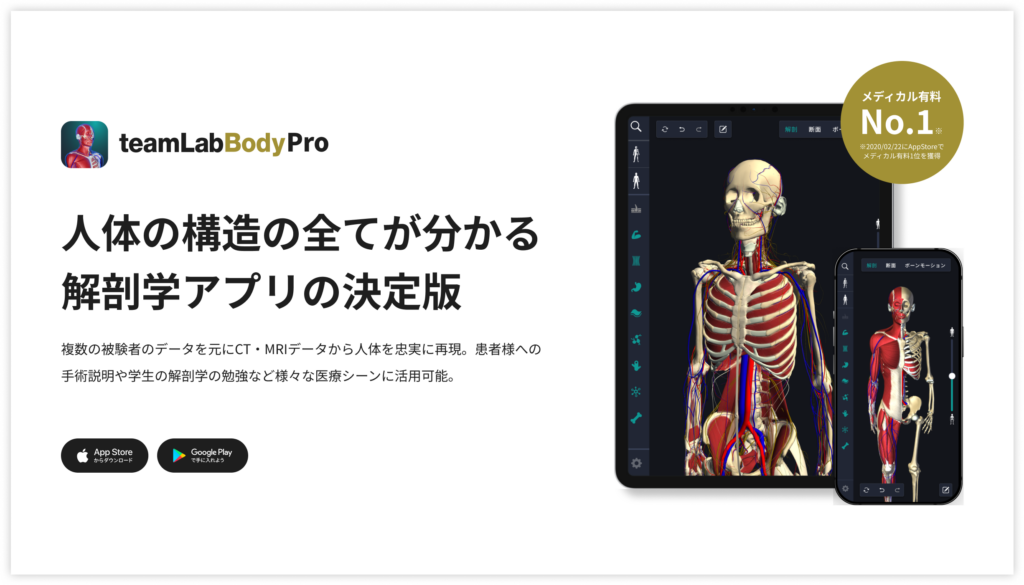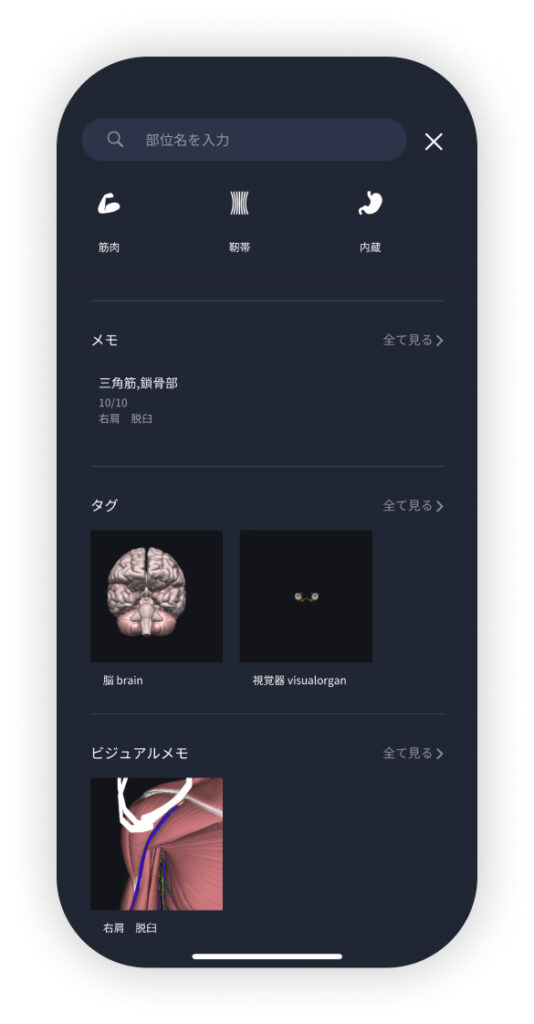beginning
In this article, I will explain effective study methods, starting with knowledge of specialized parts in human anatomy.
In human anatomy, it is necessary not only to memorize the names of various organs, muscles, and bones, but also to remember where they are located in the body. Therefore, it is necessary to learn as efficiently as possible.
I hope you will deepen your understanding even a little by reading this article and using the app.
Now, I'll explain the details about the “sphenoid sinus” and how to study human anatomy.
teamLab Body Pro Free Download
A 3D anatomy app that shows all the structures of the human body
Download teamLab Body Pro here!

What is the sphenoid sinus?
The anatomy application allows you to view a selection of anatomy 3D models. In this model, there are various observation methods such as surfaces, cross-sections, and nervous systems. This time, I'll explain using an anatomy application.
About sphenoid sinus

sphenoid sinusissphenoid boneIt is a small sinus cavity located within, behind the nasal cavity and behind the eyes on both sides. This sinus cavity is located on the wing of the sphenoid bone and is responsible for reducing facial and skull mass. Similar to other sinuses (frontal sinus, maxillary sinus, ethmoid sinus), the sphenoid sinus supports breathing and also contributes to air humidity regulation and heating.
In addition, the sphenoid sinus contributes to reducing the weight of the head and helps maintain overall balance by reducing the weight of the head. The anatomy of the sphenoid sinus is very complicated, and since there are many adjacent nerves and blood vessels, it is a particularly important part in clinical practice.
Study points
Anatomical understanding: location and structure of the sphenoid sinus
The sphenoid sinus is located within the sphenoid bone and is located behind the nasal cavity, behind the eye. This sinus, which extends over the wing of the sphenoid bone, is in contact with the lower part of the eye socket and the frontal part of the head. The sphenoid sinus communicates with the nasal cavity and ethmoid sinus, and it is important to accurately grasp the anatomical positional relationship in order to understand this point. Since there are many important structures around the sphenoid sinus, such as the optic nerve and internal carotid artery, understanding these structures is clinically essential. By using 3D anatomy apps and anatomical models, it is possible to effectively learn the three-dimensional structure of the sphenoid sinus.
Functional understanding: the role and function of the sphenoid sinus
The main role of the sphenoid sinus is to reduce the burden on the respiratory system by humidifying and warming the air. In addition, the sphenoid sinus reduces facial and skull mass and contributes to reducing head weight. When learning, it's important to understand that the sphenoid sinus works in conjunction with other sinuses. Furthermore, the sphenoid sinus contributes to reducing the weight of the skull and also plays a role in maintaining overall balance. By actually experiencing the breathing process and changes in facial pressure, you can deeply understand how the sphenoid sinus functions.
Practical application: sphenoid sinus disease
What is the most notable disease associated with the sphenoid sinussphenoid osteosinusitisIt's an infection of the sphenoid sinus or sphenoid sinus. As part of sinusitis, these diseases develop when bacteria or viruses infect the sphenoid sinus and pus accumulates. Symptoms include facial pain, headache, and nasal congestion, and may affect the optic nerve and surrounding nerves as it progresses. Although sphenoid osteosinusitis is relatively rare, special attention should be paid to since the infection can progress from an anatomical location. Clinically, early detection and proper treatment (such as antibiotics and surgery) are important. Also, since the sphenoid sinus is close to the optic nerve and internal carotid artery, sufficient consideration is required for surrounding structures during surgery or treatment.
How to study human anatomy
I will explain specific study methods using human anatomy applications.
Check your past learning history and practice repeatedly
Here are the steps to check your anatomy learning history and practice iteratively effectively.
1. Check your learning history in the app
Reviewing your learning history with the application is an important step in effectively advancing anatomy learning. First, launch the app and go to the learning history section from the main menu. Many anatomy apps are designed to show your progress in the form of graphs and lists, so you can visually check which parts you've learned about and how much time you've spent.
By using this data, you can understand which areas you have strengths in and where you need to spend more time and effort. We also recommend using a dedicated tag or notebook function to mark areas you are particularly weak at or where you need to relearn. Regularly checking your learning history and looking back on past learning content will lead to efficient review and deepening understanding.
2.Make a plan for iterative learning
Making an efficient repetitive learning plan based on learning history is extremely effective in promoting knowledge retention. First, identify weak points and areas where you need to relearn. Next, arrange these study items into a weekly or monthly calendar and create a specific study schedule. By proceeding in a planned manner, you can learn each part evenly and avoid packing in a large amount of information at once.
Using a task management app or digital calendar to set study reminders is effective. Also, it's important to have the flexibility to regularly review progress and revise plans as needed. By having goals and proceeding with your studies in a planned manner, you can efficiently acquire anatomical knowledge.
3.Use 3D features to learn visually
By utilizing the 3D function, learning anatomy is easier to understand visually. The 3D model shows the structure of the human body three-dimensionally, and each part can be observed in detail. This makes it possible to intuitively grasp positional relationships between deep muscles and organs that are difficult to capture in a planar view. For example, you can learn even the smallest details by rotating specific muscles and bones and zooming in and out.
Also, there are many apps that have the function of displaying cross-sectional views of each part using a 3D model, which is useful for deepening understanding of internal structures. This diversity of visual information helps with memory retention and improves immediate responsiveness in tests and practice situations. By utilizing the 3D function and learning visually, you can learn anatomy knowledge more deeply and efficiently.
Use the memo function concretely

Make notes so you don't forget the things and points you've noticed while studying. The memo function can be used for different purposes, such as inputting text, saving images, and writing memos. Tag your notes to make them easier to review later.
Test your learning regularly in the form of quizzes
Regularly testing what you've learned in a quiz format is a very effective way to anchor your anatomy knowledge. Quiz-style tests help you objectively grasp your level of understanding and areas you lack while repeating knowledge.
For example, by using a learning app to conduct quizzes every specific period, you can reconfirm what you've learned and strengthen your memory. There are a wide range of quiz formats, such as multiple choice questions, fill-in-the-blank questions, and short answer questions, and each helps understanding from a different angle and develops the ability to utilize various types of knowledge.
Get feedback
If possible, get feedback from other learners and experts. It helps you find your own gaps in understanding and areas for improvement. You can also keep yourself motivated to learn by regularly testing yourself. Feeling a sense of accomplishment and progress increases motivation for continuous learning.
summary
This time, I explained how to study about the “sphenoid sinus” using an application!
Thank you for reading this far.
I would be happy if reading this article helped you learn about anatomy.
Learning is a long, never-ending journey, but I sincerely wish you all the best. Let's continue to study together and work hard for the national exam!
Please look forward to the next blog.
teamLab Body Pro Free Download
A 3D anatomy app that shows all the structures of the human body
Download teamLab Body Pro here!





